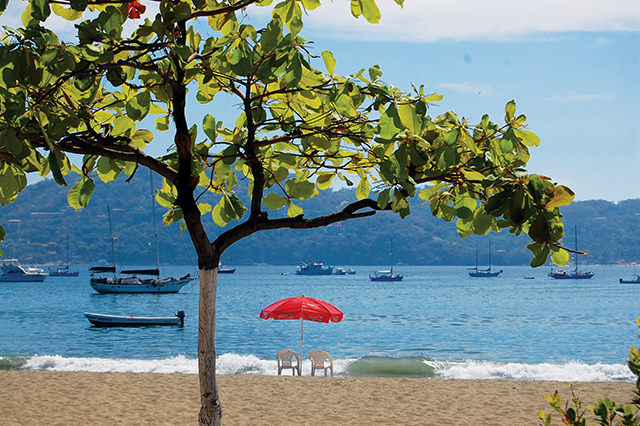Celebrating a colorful Christmas in Z-town (published December 2012)
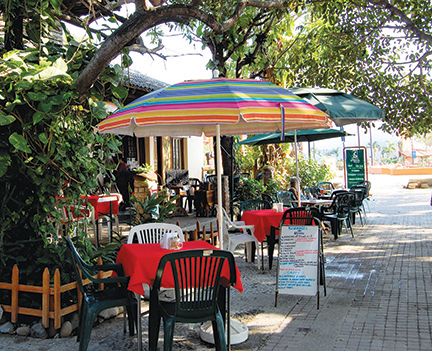
Zihuatanejo is a seaside town on the far southern Pacific coast of Mexico, known affectionately among cruisers as “Z-town,” “Z-what” or “Zihua.” Beloved for its quirky, almost hippy atmosphere, it is the natural turnaround point for most winter season cruisers in Mexico. As my husband Mark and I slipped inside the bay on Groovy, our Hunter 44DS, the town began to work its magic on us, and we quickly fell under its spell. Our first sight as we motored in was a myriad of beautiful cliff-hanging villas perched precariously above the craggy rocks. They hung out at impossible angles, as if competing with each other for the most exotic and daring posture. The architecture of each villa is unique and charming, with thatched roofs being the one common theme.
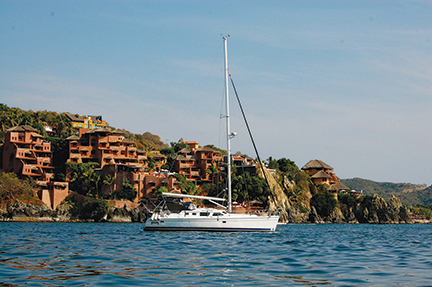
Swarms of parasailors, banana boats and jet skis descended on us as we approached the town, and a few Hobie Cats zipped by. There was a small cluster of cruising boats and “pangas,” or open fishing skiffs, anchored off the town beach. We took a spot among them below a stunning orange stucco, round turreted home that stood like a sentinel at the end of a steep bluff.
The story goes that a shipwreck long ago deposited its victims’ clothes along the bay’s largest and prettiest beach, giving it the name Playa La Ropa, or “Clothes Beach.” The wooden ship then broke up along the next smaller beach, garnering it the name Playa Madera, or “Wood Beach.” A more plausible tale is that the silks from a shipwrecked Spanish galleon that recently returned from the Orient wound up on Playa La Ropa, while the once heavily forested area behind Playa Madera gave that beach its name. However they came by their names, these pretty beaches rim the bay and join with Playa Principal, the main beach in front of the town.
When we brought our dinghy toward shore, a young shirtless Mexican fellow with an infectious gap-toothed grin dashed into the water to greet us. “I help you,” he explained as he walked the dinghy to the sand. We stepped out and he grabbed the painter and charged up the beach, dragging the dink to rest alongside a few other cruisers’ dinghies. Like many Mexicans we met in our travels, he had created a job for himself: dinghy valet. “I watch for you,” he said, pointing to the dinghy earnestly. Mark fished a few pesos out of his pocket for him. We soon learned that our valet, Alfonso, worked the beach with a few buddies, and each time we came ashore one of them would greet us in the same manner. Hours later, sometimes well after dark, they would greet us again when we returned and wade out waist-deep in the water to help us launch. It wasn’t a service we needed, but it was a fun part of the warm, funky culture of the place.
A SOFT SELL
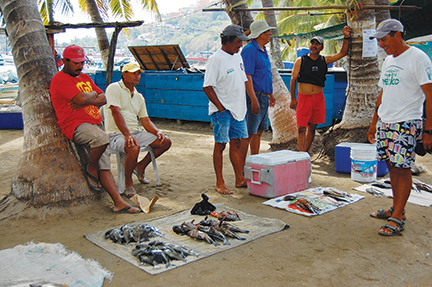
Zihuatanejo was undergoing a major facelift when we arrived, and construction workers scurried everywhere readying the town center for the imminent holiday celebrations. The streets fronting the palm-studded town beach are pedestrian-only, lined with colorful boutique shops and delightful outdoor restaurants. Proprietors and salesmen stand outside their shops and restaurants, coaxing the tourists to take a peek inside. “Your table is waiting,” a waiter said to us as we walked by. He gestured grandly toward an elegant array of tables outside an upscale-looking restaurant. Mark, who loves to banter with these guys, said “Ya comimos,” trying out a new Spanish phrase he’d learned, “We already ate.” “Then try one of these hats, or buy something else you don’t need!” said the eavesdropping shopkeeper next door as he waved towards racks of trinkets behind him. The gentle hustling is all in good fun, and a smiling “No, gracias,” was readily accepted.
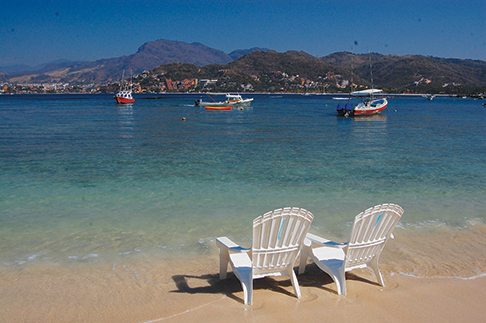
The town beach lies just beyond the first row of shops, and it is lined with fishermen who sell their catch from coolers and tarps in the sand. Little piles of colorful fish were on display, and although the fishermen didn’t know all the names in English, we soon learned that the golden polka dotted Sierra, or Spanish Mackerel, was very tasty. This casual, sandy, barefoot style of selling the daily catch under the palms harkens back to Zihua’s less developed past. But in recent weeks the town center had been gussied up with a brand new bandstand, a new basketball court and a tropical garden filled with sculptures of native animals.
CHRISTMAS CAROLS,
Z-TOWN STYLE
A tree in the middle of the town square had been decorated for Christmas, and a nativity scene had been set up nearby. The tree wasn’t a spruce and it didn’t have the professional Christmas tree look about it that dominates the corporate Christmas season back home. Instead, it was a straggly deciduous tree that looked a little funny with a smattering of ornaments hanging from its skinny branches. But the town’s Christmas spirit wasn’t to be found in the decorations. Instead, two huge loudspeakers took that honor. Each night, starting at dusk, those speakers thumped a steady beat of exuberant music across the anchorage until the wee hours of the morning. Mexicans love their music, and they love it loud, and they love it all night long—especially at Christmas.
The cruisers grumbled a little among themselves about all the noise, but it was a small price to pay for spending the holidays anchored off a vibrant town in the tropics. There were 13 cruising boats in the harbor, and although we were new to the cruising life and had been out just six weeks, I got a VHF radio cruisers net going in the mornings. I didn’t always follow the official broadcast format that’s enforced at other anchorages, but with just a few folks listening it didn’t matter. What did matter was how best for all of us ex-pat sailors to celebrate Christmas. Seasoned cruisers were concerned that their favorite cruiser hangout, Rick’s Bar, was under new ownership, and a few suggestions of other places for a get-together were tossed about.
As it turned out, Rafa, the new owner of Rick’s, was very eager to fill his predecessor’s shoes as the prime hangout for cruisers, and he easily agreed to give the salty crowd happy hour prices for as long as we would stay on Christmas Eve. That deal sure drew the cruisers in. From 2pm until nearly 10pm, 35 cruisers, friends and family kept Rafa and his son Carlos hopping. The place was bursting with laughter and overflowing with people all evening.
The beauty of that crazy Christmas Eve celebration was that now all the cruisers knew each other, old-timers and newcomers alike. One afternoon we all took our dinghies for the mile or so ride over to Las Gatas Beach on the far side of the bay. This pretty boat-in only beach is enclosed by a pile of stones that legend says a pre-Hispanic indigenous chief put in as a breakwater to create a perfect swimming hole for his daughter. Of course there is another legend that claims the stones were ballast dumped from Spanish galleons back when this harbor was New Spain’s primary port for trade with the Philippines. Either way, the tranquil waters and white sand beach are deliciously inviting, and the cruisers rafted their dinghies together for a free-floating afternoon of fun on the water.
LOCAL TOURISTS
Z-town has been a cruiser favorite for many years, and old-timers miss the days when it was a little less busy. “It’s overrun with cruise ships,” we had heard. Imagining a harbor filled with massive Carnival Cruise Lines ships, we were surprised that only three ships arrived during our month in town. Each one turned out to be not only a small ship but in the midst of an unusual voyage that included transiting the Panama Canal.
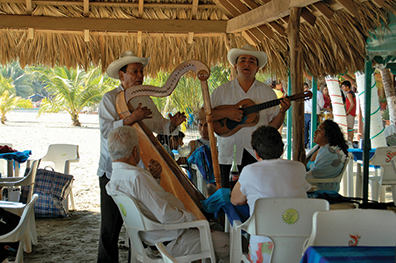
The charming walking district of shops along the beachfront is aimed at tourists, but what I liked was that most of the tourists were Mexicans. Families meandered along the paths enjoying their Christmas vacation, animated Spanish conversation flying. Mariachi bands of all shapes and sizes wandered the restaurant-lined streets and beach bars. Gringos rarely spring for a serenade, but the Mexicans not only eagerly asked for their favorite songs, they knew all the words and sang along. Some ballads had a mournful air, telling tales of unrequited love, while others were upbeat and fast-paced, eliciting smiles all around. The band members dressed in festive, matching clothes. Most bands featured a guitar or two, but some had trumpets or violins, and one trio even had a harp they lugged from table to table.
IN A FOREIGN LAND
Behind the waterfront walking streets, the more urban part of Zihuatanejo reaches toward the high-rise glitz of Ixtapa a bus ride away. Strolling along these dusty, busy streets we soon found the main Mercado Publico, which filled a full city block. We entered the hustle of this indoor market by the fruit stalls. Beautiful fresh produce of all varieties hung from hooks and was displayed in bins. We passed stalls of red meats where whole sides of beef dangled from hooks and a skinned goat had been strung up by a hind foot. My eyes like saucers, I soon found myself staring at a table filled with whole plucked chickens, toes splayed in the air and heads lolling over the edge. This was proof positive for me that we were in a foreign land. Short dark women whose heads barely came to my shoulder reached across the tables eagerly, negotiating with the sellers in quick staccato voices, nodding their heads assertively.
Those chickens weren’t appealing to me, as they had been sitting at room temperature since the market opened hours earlier, but outside the market we stopped at a small stand selling “pollo asado,” or grilled chicken. “They’re delicious,” an experienced cruiser had told me, “We like the ones that look like roadkill.” We soon agreed wholeheartedly. Sliced open along the sternum and laid flat across the grill, these chickens are fantastic. Sold with flavorful rice and corn tortillas, they make a scrumptious and easy take-home dinner on the boat. Even better, they are the ideal foundation for the first few meals on a passage.
In no time, it seemed, a month had passed. While friends and family at home in cold country had been living through a snowy, white Christmas, we had experienced a vibrant, multi-colored, warm one in Z-town. Our hearts were captivated by this spirited bay, and as we reluctantly pointed our bow north, we knew that our vivid memories of a unique holiday season in Mexico would stay with us forever.

Emily Fagan, a lifelong sailor, lives aboard her Hunter 44DS Groovy with her husband, Mark. Groovy has cruised up and down (almost) the entire Mexican Pacific coast and Sea of Cortez. Traveling full-time since 2007, Emily and Mark share their adventures at www.RoadsLessTraveled.us
GUIDES
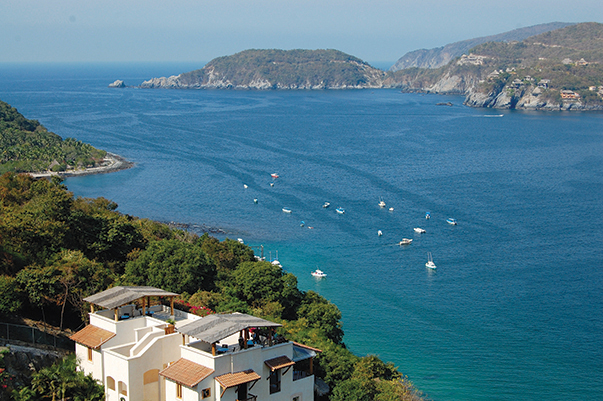
There are three major cruising guides to help you sail to Zihuatanejo. Each offers a slightly different perspective and has excellent insights: Mexican Boating Guide by Capt. Pat Rains, Pacific Mexico: A Cruiser’s Guidebook by Heather Bansmer and Shawn Breeding, and Charlie’s Charts: Western Coast of Mexico by Charles and Margo Wood
SAILFEST
Zihuatanejo is a perfect place to entertain guests from home. The airport is just seven miles from town, and there are many options for lodging if you choose not to host your guests aboard overnight. We loved our Christmas stay in Z-town, but most cruisers prefer to go there for Sailfest, a cruiser and resident expat fundraising event held each February to benefit local schoolchildren. Check out www.zihuasailfest.com for more info.















